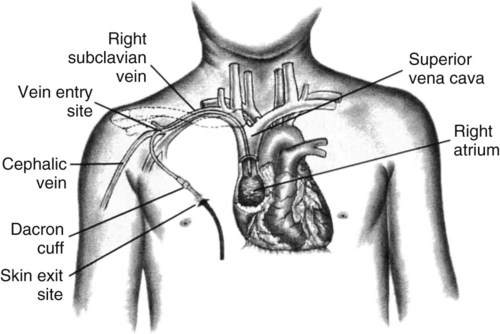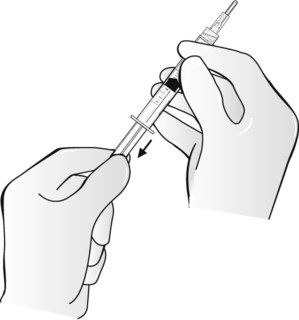This section may be photocopied and distributed to families. A catheter (tube) was placed in your child so that an intravenous (IV) line will be available for long-term treatment. This tube can be used to give medications, fluids, and nutrients and possibly to obtain blood specimens. Several different types of catheters can be used, such as the Broviac or the Groshong. Both types of catheters are inserted under the skin and into a major blood vessel near the heart (Figure 1). Needleless cannula and syringe or needle and syringe (10-ml size) Bottle of heparin (concentration will be determined by the practitioner) at room temperature (Broviac) or bottle of sterile injectable saline at room temperature (Groshong) In some situations a bottle of heparin mixed with saline may be used 1. Gather equipment that you will need, and place on a clean, dry surface. 2. Wash your hands with soap and water. Count to 10 while washing, then rinse with clear water and dry with a clean paper or cloth towel. 3. Open the package of antiseptic swabs. 4. With one of the swabs, scrub the top of the solution bottle for about 10 seconds. Let the bottle top dry. Do not touch the bottle top after you have cleaned it. 5. Open the package of the bottle adapter, and push the pointed end straight into the rubber top of the bottle. It may take some force to do this, but do not try to twist the adapter into the bottle top. 6. Open the package containing a new syringe, and remove the cap from the tip of the syringe. Do not touch the exposed part. 7. Open the package of the needle cannula by pulling apart the wrapping at the top of the package. Connect the tip of the syringe to the opening of the cannula by twisting the two pieces together. 8. Remove the cover of the cannula. Do not touch any part of it. If you do touch it, use a new one. 9. If you are using a syringe with a needle, you do not need the bottle adapter. Just follow steps 6 through 8, substituting the needle for the cannula. Sometimes the syringe and needle are already attached. 10. Pull back the plunger, and fill the syringe with the same amount of air as needed (Figure 2).
Wilson & Hockenberry: Wong’s Clinical Manual of Pediatric Nursing, 8th Edition
Patient Teaching Guide
Caring for a Central Venous Catheter

Equipment
Instructions
![]()
Stay updated, free articles. Join our Telegram channel

Full access? Get Clinical Tree


Wilson & Hockenberry: Wong’s Clinical Manual of Pediatric Nursing, 8th Edition: Patient Teaching Guide
Get Clinical Tree app for offline access

